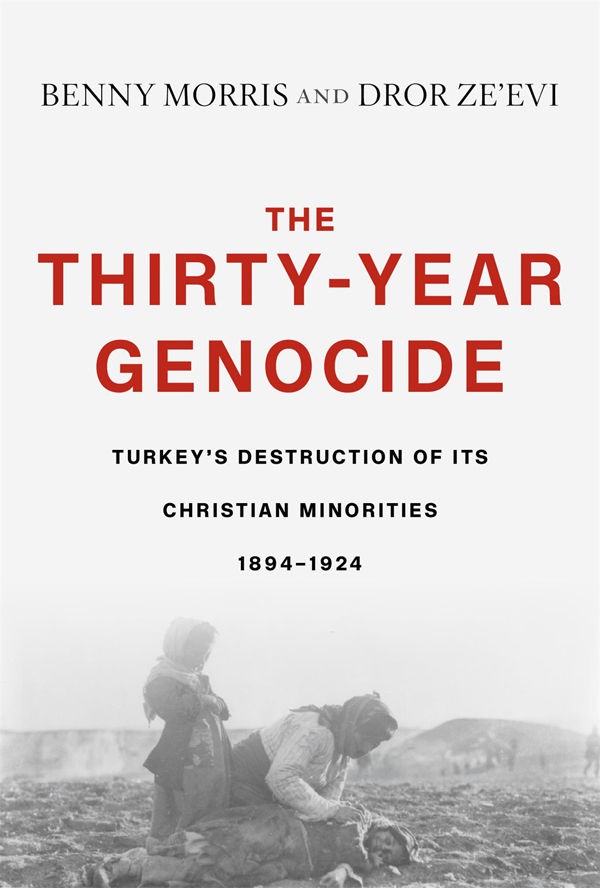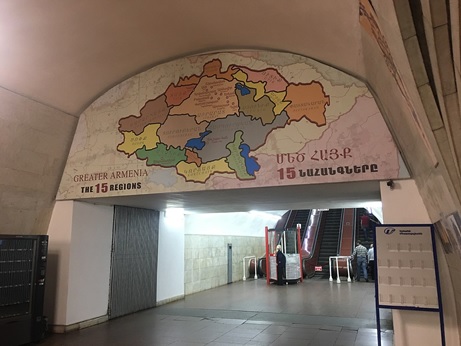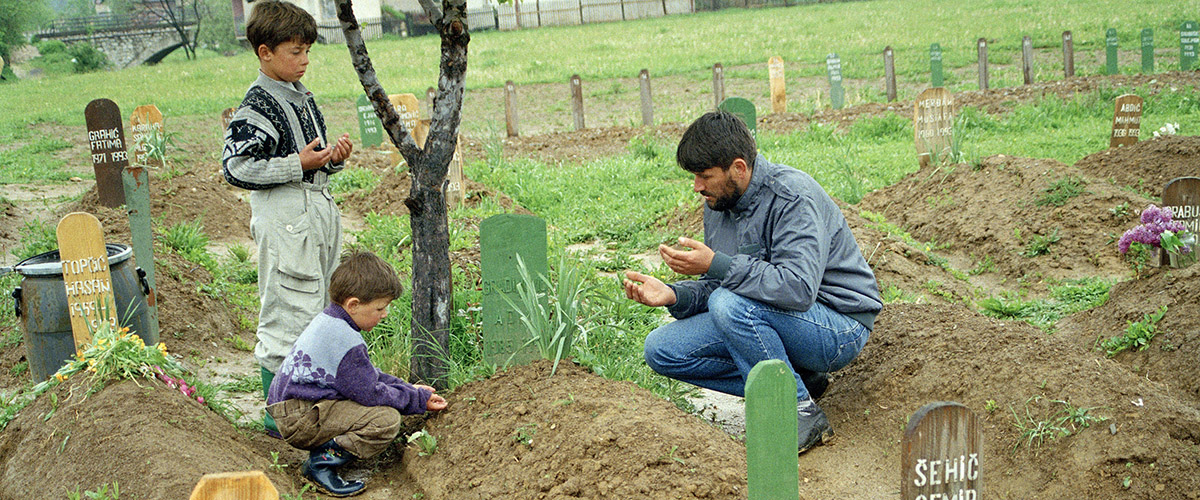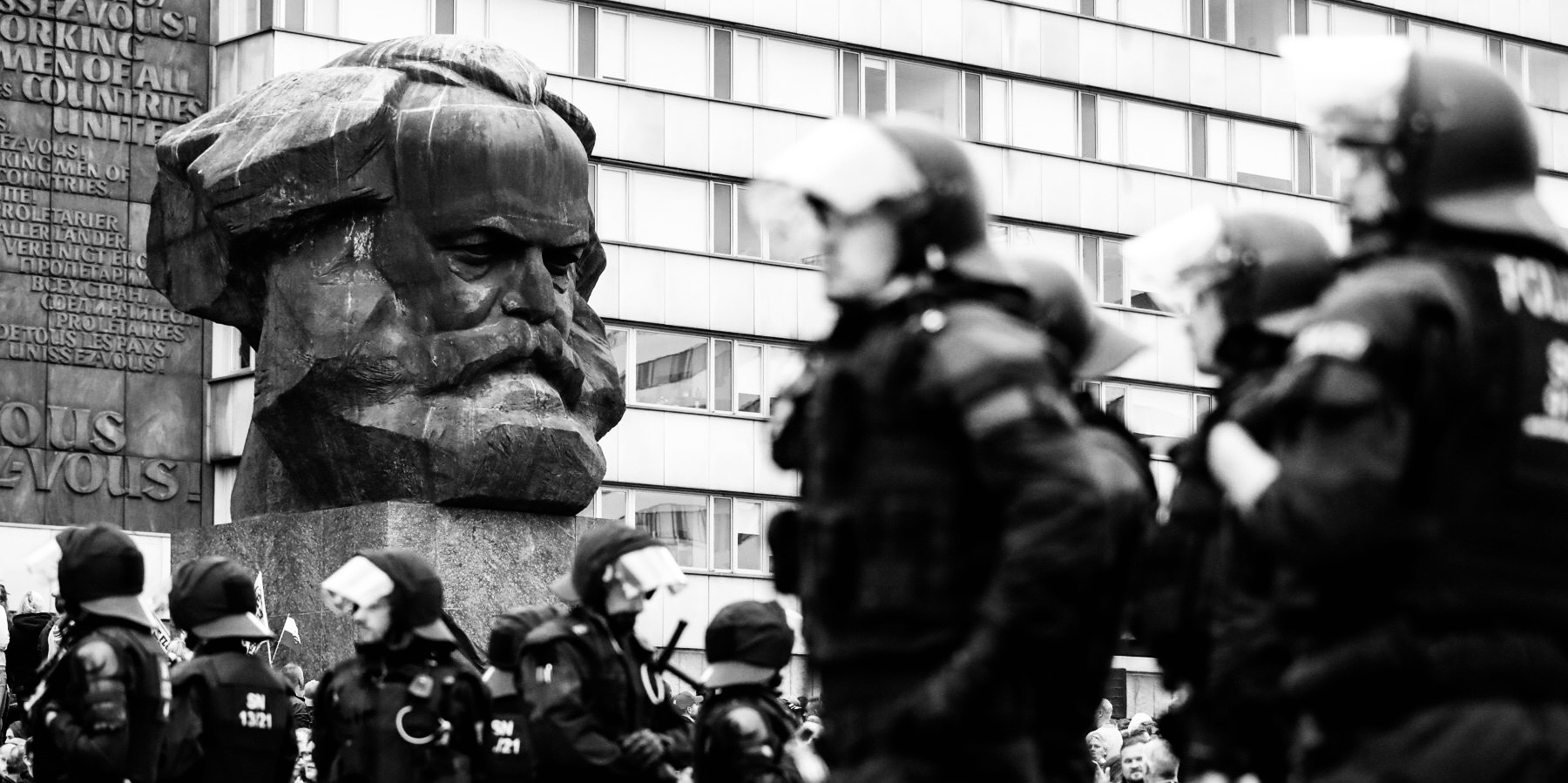
Benny Morris and Dror Ze’evi, The Thirty-Year Genocide. Turkey’s Destruction of its Christian Minorities 1894-1924 (Cambridge Mass: Harvard University Press, 2019), 672 pp.
Two Israeli scholars, Benny Morris and Dror Ze’evi published a highly polemical, distorted and biased account on the late Ottoman period. Unsurprisingly, the book has been reviewed in an effusively positive light. Writing for the New York Times Book Review, Bruce Clark described it as a “subtle diagnosis” and an impressive account. Robert Fisk gave it a similarly positive assessment in the Independent. For Eleni Sakkelis, The Thirty-Year Genocide is “a must read” while Svante Lundgren described it as “outstanding.” The common feature of all these reviewers is their unfamiliarity with the late Ottoman history. Thus, the book did not receive any serious critical attention from the specialists of the field.
The Thirty-Year Genocide is not a work of meticulous and balanced scholarship, but a biased account written with rage that presents a hasty and amateurish compilation of historical events, relying at times on discredited or distorted evidence. The authors’ narrative has serious flaws in terms of chronology and the sources they use. Many of the references provided by the authors remain merely as window dressing and have no relation whatsoever to the authors’ contentions. Indeed, quite often the authors’ citations actually contradict their claims.
The book consists of nine chapters, organized in three main sections. The first section deals with the 19th century and the events of 1890s. The second section covers the Young Turk Period from 1908 to the end of the World War I. The final and the third section is focused on the 1919-1922 period. This review will focus on the first two sections of the authors’ study. The last section of the book, dealing with the Greek and Assyrian experiences, similarly full of distortions, deserves a thorough examination on its own and will not be examined here.
Heavily influenced by tired clichés, the authors’ account argue that Muslim Turks have always oppressed Christians and particularly the Armenians. Later on, oppression allegedly turned to unprovoked massacres and took the form of genocide from 1890s to 1920s in an uninterrupted state campaign to exterminate the Christian populations of the Ottoman Empire.
However, the authors are entirely silent on the violent manner in which Muslim populations of the Balkans, Crimea, and the Caucasus had been destroyed and deported and forced to flee their ancestral homelands and at times even deny or attempt to justify their sufferings. Indeed, the authors’ narrative is not a scholarly analysis of what happened or why in the late Ottoman period but often degenerates into the caricature of “the terrible Turk.”
In this simplistic picture, the entire history of a multi-national empire is reduced to tales of uninterrupted subjugation and suffering of Christian populations. The reality, however, was much more complex and interesting; a brief look at the socio-economic position of the Armenians in the empire clearly shows the problematic nature of the author’s narrative. Not only did the Armenian Patriarchate and the Armenian Amira class have amicable relations with the Ottoman Government for centuries, but also the Armenian peoples of neighboring Caucasus and Iran immigrated to the Ottoman Empire because of its stability, security and better living standards. Right until the end of the Ottoman Empire, there were high-ranking Armenian bureaucrats, ambassadors, and even cabinet ministers serving the Ottoman State. Even as late as 1917, Talat Pasha’s cabinet included an Armenian minister. Morris and Ze’evi mention none of these. Indeed, they show no consciousness at all that they are even familiar with these aspects of the Ottoman-Armenian history.
The authors’ lack of familiarity with the late Ottoman history reveals itself in a number of embarrassing mistakes. According to Morris and Ze’evi, in April 1876 when “the Bulgarians” rose in rebellion against the Ottoman State “Abdülhamid responded with a hard line,” moving to “crush the Bulgarian rebellion, curtail the new freedoms” and he also “suspended the constitution; dispersed the parliament; and sent his irregulars, the Başı Bozuks, to quash the Bulgarians” (pp. 16-17). By April 1876, Abdülhamit was not yet the Sultan. He came to the throne only in late August 1876. Therefore he could not have sent any irregulars to suppress a rebellion that took place in April. Moreover by April 1876, there was as yet no Ottoman Constitution and Parliament as they were only proclaimed in December 1876; thus no Sultan could actually suspend a constitution or disperse a parliament that did not yet exist. Furthermore, in line with their generally biased attitude, the authors of course fail to mention that the Bulgarian Rebellion of April 1876 was accompanied by massacres of Turkish peasants who had been killed brutally by the Bulgarian rebels.
When the authors discuss 1890s, they rely on a number of unreliable sources who did not actually witness the incidents but passed on rumors and second or even third-hand information. They make no mention of the fact that almost all well-informed foreign observers agreed that during this time the Armenian revolutionary groups were actually engaged in provoking their Muslim neighbors by acts of violence and terror in the hope of forcing Great Power intervention. Their claim that up to 300,000 Armenian deaths (p. 132) during the violent incidents which engulfed the region in mid-1890s is a gross exaggeration and goes against the demographic realities of the region. In Sasun, where according to the authors up to 6 thousand Armenians were massacred (p. 60), an investigative commission found out that actually 265 Armenians lost their lives and that this figure included the Armenian revolutionary combatants.
In the second section of the book the authors discuss the Young Turk period. According to the authors, the Young Turks’ main goal was to Turkify the empire through violent means and in line with this view they saw the empire’s Christian populations in general and the Armenians in particular as a threat. (p. 137-148.) This approach fails to explain why many contemporary prominent Armenians praised the CUP rule in the aftermath of 1908. Many Armenians, including the Dashnaks, praised the CUP administration, stating that visible improvements had taken place. A prominent Dashnak for instance noted that under the Young Turks, “the population’s living standard has risen by at least twenty-five percent.” The authors, however, mention none of these and depict an entirely negative and unbalanced picture.
According to Morris and Ze’evi, the Young Turks “were driven by their commitment to what they understood as the Turkish race” and “consistent with the guiding notion of pan-Turkism (Turanianism), the CUP sought the political union of all ethnic groups speaking Turkic languages, from China’s Uyghurs to Eastern Europe’s Tatars and Turks” (p. 137). As a source for this rather bold claim, the authors cite page 39 of Feroz Ahmad’s The Making of Modern Turkey, where Ahmad writes nothing supporting the authors’ contention. Indeed, the words pan-Turkism and Turanism are not even mentioned by Ahmad in his book, let alone any statement to the effect that Young Turks sought the political union of all Turkic peoples in a wide geography. On the contrary what Feroz Ahmad writes on that page quite openly contradict the authors’ allegations: “Despite the increasing importance of Turks as the most significant numerical group, Islam not nationalism received the most emphasis; only some intellectuals in the capital took Turkish nationalism seriously.” The authors display this rather cavalier attitude to their sources throughout the book and frequently go beyond their sources and put forward contentions which are not supported by their citations.
The authors also devote much space to the Ottomans’ entry into the world war and the declaration of holy war against the Entente Powers (pp. 146-148). However they do so without noting and contextualizing the Ottoman efforts to reach an understanding with the Entente Powers in the months leading to the Ottoman entry to the war. These efforts failed largely because the Entente Powers were not willing to consider the Ottomans’ legitimate security concerns. The authors, however, omit all these details and present an apocryphal version of events where the Ottoman leaders appear as war-mongers eagerly seeking to engage in a war of aggression.
According to the authors, in November 1914 “the Şeyhülislam, the chief Ottoman cleric, Mustafa Hayri, who happened to be a member of the CUP central committee, issued a fatwa” proclaiming the holy war. By November 1914 Mustafa Hayri Efendi was not yet a member of the CUP’s Central Committee. When he became a member of the Central Committee in late 1916, he was no longer “the Şeyhülislam,” having vacated that post in early 1916.
Likewise, the authors’ depiction of the Ottoman leaders as enthusiastically seeking to proclaim the holy war also contradicts the historical record. Noting the illusory nature of a global, pan-Islamic revolution, for instance, Enver Pasha suggested to the Germans that rather than declaring holy war, it would be better for the Sultan to “call upon all Muslims to take up arms against the powers of the Triple Entente.” But it was ultimately Kaiser’s and Berlin’s insistence and belief in the holy war and its potential contribution in a war against Britain that led to its declaration. Years later, Kazım Karabekir, who during the war served as the head of the intelligence section at general headquarters, recalled with irony that “Ottoman state dignitaries had much less faith in the Cihad than the Germans.” And a quick glance at Tilman Ludke’s study, Jihad Made in Germany, could have allowed the authors to base their arguments on more balanced and solid ground but as so often the authors’ account lacks nuance.
The authors neglect to mention important episodes in their narrative. For instance, there is no mention of the Dashnaks’ important congress in Erzurum in the summer of 1914. Likewise the authors do not mention Russia’s role in the Kurdish disturbances of 1912-1914 which enabled Russia to diplomatically intervene in the Ottomans’ internal affairs. Similarly there’s no mention of the Russian plans and Russia’s communication with the Ottoman Armenians to use the latter for an uprising behind Ottoman lines to support the Russian war effort. There’s no mention of the intensive armaments among the Ottoman Armenians in Eastern Anatolia from late 1912 onwards. All these omissions enable the authors to portray the Ottoman State as the invariable aggressor and the Ottoman Armenians as helpless victims who had no role whatsoever in the flow of events.
The considerable documentation and correspondence contained in the Russian Archives concerning the Ottoman Armenians’ preparations for an armed uprising with Russian support establishes that not all Ottoman fears concerning the Armenian activities were paranoia as the authors would like to argue. The recent discoveries by Sean McMeekin, for example, indicate that the Ottoman military intelligence reports and Russian Diplomatic-Military reports corroborate each other on this issue to a surprising extent. The Russian Consul in Erzurum for example noted that the rebels in Erzurum had carefully “hidden their weapons in secret storage caches.” Moreover, “it is not only the Armenian population of Erzurum … but also in all cities surrounding it, including Erzincan, Sivas, Mana Hatun and Kayseri, not to mention in the villages and rural areas, who are awaiting with impatience the arrival of Russian troops who will free them from the Turkish yoke.” (Sean McMeekin, the Russian Origins of the First World War, p. 164). Again, the authors entirely ignore this point and insist on their narrative one-sided narrative of oppression and victimization.
Morris and Ze’evi place a special emphasis on the months of March and April as far as the CUP’s decision making is concerned. According to the authors, “evidence shows a small circle of CUP activists began the planning [for genocide] in the wake of the debacle at Sarıkamış” (p. 249) yet they fail to provide any source for their alleged “evidence.” A few pages later they repeat a similar charge but this time with a reference to source: “According to the testimony of CUP officials at the postwar trials, the pivotal planning meetings [for genocide] occurred in March and April, as CUP leaders summoned provincial administrators and CUP representatives to Constantinople” (p. 251). They provide no evidence for the existence of any discussion or even any suggestion among the CUP officials concerning this but merely provide speculations. Instead they refer to Taner Akcam who, in turn, refers to the indictment of the main trial of the CUP leaders held in 1919. Both the authors’ arguments and their source, however, are problematic. The indictment a) does not specify any date or month for the alleged planning, b) does not quote any testimony from the CUP officials, c) doesn’t quote any document to show such planning had been done. The indictment merely provides speculations that the CUP must have arrived such a decision after long deliberations without, however, quoting any evidence that such meetings took place. In other words, Morris and Ze’evi’s allegation that the CUP held meetings for planning a genocide in March and April is simply unfounded and has no basis in the sources they refer to.
As a follow-up to their argument that the CUP had planned to execute a genocide in March and April, the authors argue that around the same time in April, a large group of convicts were released from the prisons to carry out the alleged genocide: “at the same time, according to a series of telegrams exchanged between the Interior Ministry and some of the eastern vilayets, another large group of convicts was released from prison to participate as “volunteers” and gang members in the forthcoming campaign” (p. 251). As so often, the authors’ argument has no factual basis. The authors again refer to Akçam to buttress their claim yet according to their source, the prisoners were not released in April 1915 but in November and December 1914 right after the empire entered the war against Russia and long before the alleged planning took place. In addition, the released prisoners did not form a “large group” as the authors argue; they were small groups, not exceeding a few hundreds.
The authors discuss the Van rebellion of April 1915 in an extremely unbalanced fashion, failing to mention that months before the rebellion the Armenian revolutionaries in town were in communication with the advancing Russian forces and were coordinating their actions with the enemy forces. Similarly the authors neglect to mention that during and after the rebellion, the insurgents committed large scale atrocities on the Muslim civilian population of Van. Aram Manukian, the Dashnak leader of the rebellion and who later was appointed as the new governor of Van by the invading Russian forces, actually ordered the plunder and destruction of Muslim dwellings in Van. Later on, he even suggested that the Kurdish population of the area should be massacred. Yet none of these critical details are mentioned by the authors, who present an unabashedly anti-Turkish narrative throughout their study and fail to contextualize the role of these events in the Ottoman Government’s decision to relocate the Armenians.
Their discussion of the relocations themselves are similarly flawed and their source base is extraordinarily one-sided. They neglect to mention Talat Pasha’s considerable efforts to prevent and reduce the hardships experienced by the relocated Armenians. His telegrams ordering the protection of the convoys, the distribution of food and other supplies and the punishment of officials and other elements mistreating the Armenians are entirely ignored by the authors. More than 1600 people were put on trial and 69 people had been executed for mistreating the Armenians. Still many others were sentenced to various sentences, including hard labor and prison. The authors mention or discuss none of these efforts and reach their conclusion of a genocide through a great deal of omission and selectively using sources.
The Thirty-Year Genocide is not a work of balanced scholarship, but a biased account written on the basis of carefully selected events and sources that ignores many crucial events and sources which contradict the authors’ thesis. Despite the impressive size of the study, it offers virtually nothing new in terms of sources and insights and ideas. Instead, the authors merely present a hasty and amateurish compilation of historical events, devoid of their historical context and which often suffers from selective use of sources, subjectivism, and the inability to synthesize the materials used in the book.
© 2009-2025 Center for Eurasian Studies (AVİM) All Rights Reserved
No comments yet.
-
 THE NORTH MACEDONIA-BULGARIA DISPUTE AND THE CONFUSING WAY EU DEALS WITH CHALLENGES
THE NORTH MACEDONIA-BULGARIA DISPUTE AND THE CONFUSING WAY EU DEALS WITH CHALLENGES
AVİM 12.01.2021 -
 ARMENIA’S DESPERATE SEARCH FOR FOREIGN INTERVENTION AND ITS HISTORICAL ANTECEDENTS: “THREADS OF CONTINUITY”
ARMENIA’S DESPERATE SEARCH FOR FOREIGN INTERVENTION AND ITS HISTORICAL ANTECEDENTS: “THREADS OF CONTINUITY”
AVİM 14.10.2020 -
 WE ARE LOOKING FORWARD TO A WORLD FREE FROM THE CRUEL AND ODIOUS CRIME OF GENOCIDE
WE ARE LOOKING FORWARD TO A WORLD FREE FROM THE CRUEL AND ODIOUS CRIME OF GENOCIDE
AVİM 18.12.2017 -
 THE ROOTS OF “NEMESIS” AND THE BACKGROUND OF RADICAL ARMENIAN NATIONALIST TERRORISM
THE ROOTS OF “NEMESIS” AND THE BACKGROUND OF RADICAL ARMENIAN NATIONALIST TERRORISM
AVİM 11.05.2023 -
 DASHNAK FEDAIS: HEROES OR CALAMITIES OF THE ARMENIAN PEOPLE?
DASHNAK FEDAIS: HEROES OR CALAMITIES OF THE ARMENIAN PEOPLE?
AVİM 20.12.2019
-
IGNORED DANGER: MEDZAMOR NUCLEAR POWER PLANT
Tutku DİLAVER 19.12.2018 -
 ADMISSION BY KATI PIRI: “ALLOWING CYPRUS IN (EU) WITHOUT A SOLUTION TO CYPRUS PROBLEM… IS A BIG MISTAKE”
ADMISSION BY KATI PIRI: “ALLOWING CYPRUS IN (EU) WITHOUT A SOLUTION TO CYPRUS PROBLEM… IS A BIG MISTAKE”
Teoman Ertuğrul TULUN 01.04.2019 -
 THE EUROPEAN COURT OF HUMAN RIGHTS’ APPROACH TO NEGATIONISM AND REVISIONISM AND SOME DEDUCTIONS ON PERINÇEK V. SWITZERLAND CASE
THE EUROPEAN COURT OF HUMAN RIGHTS’ APPROACH TO NEGATIONISM AND REVISIONISM AND SOME DEDUCTIONS ON PERINÇEK V. SWITZERLAND CASE
Turgut Kerem TUNCEL 16.11.2015 -
 AFD’S SLOGAN: THE MORE REFUGEES, THE MORE VOTES
AFD’S SLOGAN: THE MORE REFUGEES, THE MORE VOTES
Hazel ÇAĞAN ELBİR 09.04.2020 -
 THE RISING STRATEGIC IMPORTANCE OF TÜRKIYE'S MIDDLE CORRIDOR IN EURASIA AMID THE UKRAINE CONFLICT
THE RISING STRATEGIC IMPORTANCE OF TÜRKIYE'S MIDDLE CORRIDOR IN EURASIA AMID THE UKRAINE CONFLICT
Teoman Ertuğrul TULUN 29.05.2024
-
25.01.2016
THE ARMENIAN QUESTION - BASIC KNOWLEDGE AND DOCUMENTATION -
12.06.2024
THE TRUTH WILL OUT -
27.03.2023
RADİKAL ERMENİ UNSURLARCA GERÇEKLEŞTİRİLEN MEZALİMLER VE VANDALİZM -
17.03.2023
PATRIOTISM PERVERTED -
23.02.2023
MEN ARE LIKE THAT -
03.02.2023
BAKÜ-TİFLİS-CEYHAN BORU HATTININ YAŞANAN TARİHİ -
16.12.2022
INTERNATIONAL SCHOLARS ON THE EVENTS OF 1915 -
07.12.2022
FAKE PHOTOS AND THE ARMENIAN PROPAGANDA -
07.12.2022
ERMENİ PROPAGANDASI VE SAHTE RESİMLER -
01.01.2022
A Letter From Japan - Strategically Mum: The Silence of the Armenians -
01.01.2022
Japonya'dan Bir Mektup - Stratejik Suskunluk: Ermenilerin Sessizliği -
03.06.2020
Anastas Mikoyan: Confessions of an Armenian Bolshevik -
08.04.2020
Sovyet Sonrası Ukrayna’da Devlet, Toplum ve Siyaset - Değişen Dinamikler, Dönüşen Kimlikler -
12.06.2018
Ermeni Sorunuyla İlgili İngiliz Belgeleri (1912-1923) - British Documents on Armenian Question (1912-1923) -
02.12.2016
Turkish-Russian Academics: A Historical Study on the Caucasus -
01.07.2016
Gürcistan'daki Müslüman Topluluklar: Azınlık Hakları, Kimlik, Siyaset -
10.03.2016
Armenian Diaspora: Diaspora, State and the Imagination of the Republic of Armenia -
24.01.2016
ERMENİ SORUNU - TEMEL BİLGİ VE BELGELER (2. BASKI)
-
AVİM Conference Hall 24.01.2023
CONFERENCE TITLED “HUNGARY’S PERSPECTIVES ON THE TURKIC WORLD"









